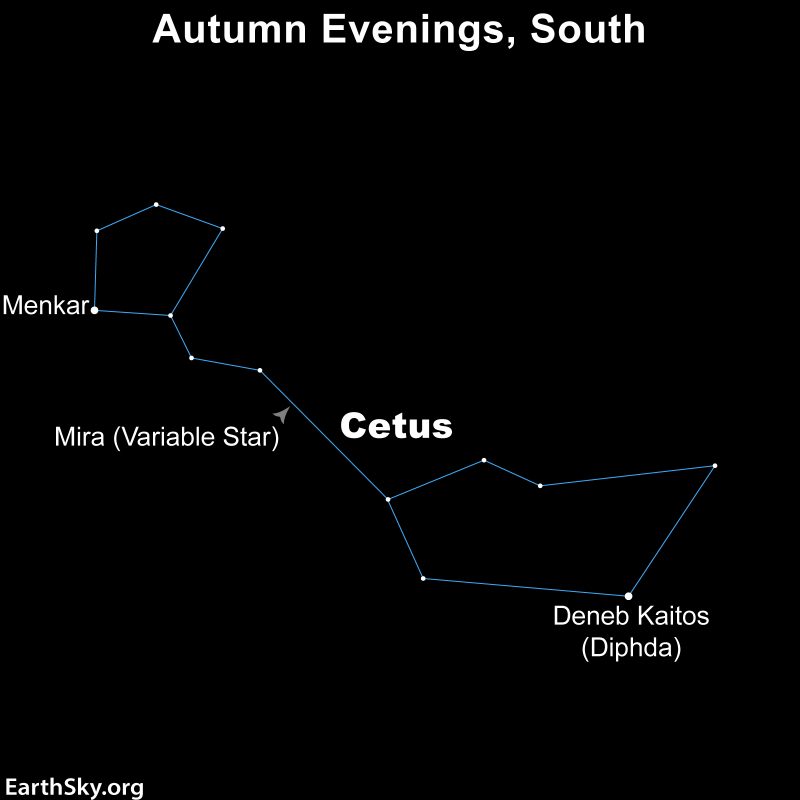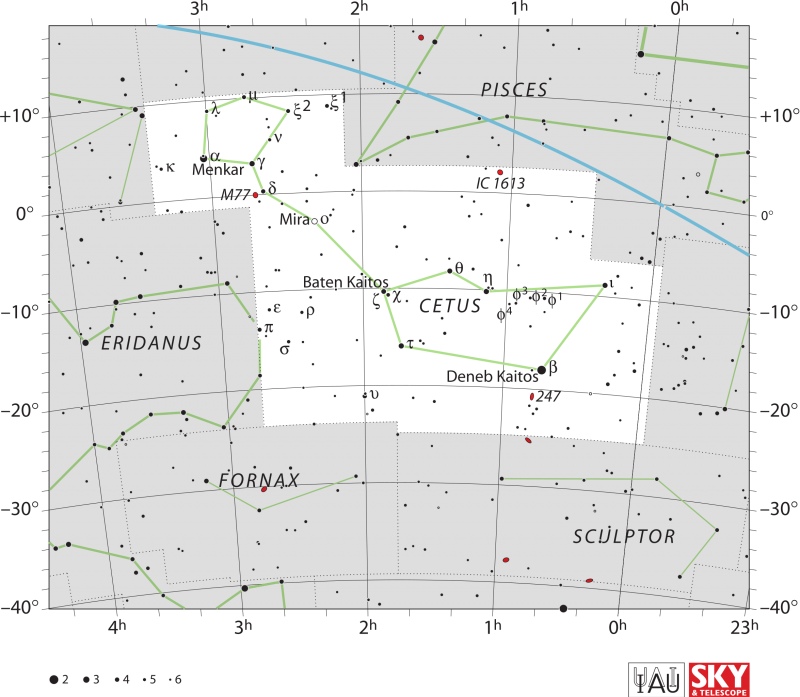
Menkar in Cetus the Whale
Menkar isn’t the brightest star in Cetus the Whale. Instead, Diphda – aka Deneb Kaitos, the Whale’s Tail – is brightest. And Menkar isn’t even the Whale’s most famous star. That honor goes to Mira, sometimes called Mira the Wonderful, a renowned variable star.
Still, Menkar is an interesting star, with its own claims to fame. It’s the 2nd-brightest star in Cetus at a +2.6 magnitude. And it’s designated the alpha star in Cetus. Why? It could be because Menkar sits closer to the ecliptic, which marks the sun’s yearly circuit in front of the background stars.
What’s more, Star Trek fans might recognize the name Menkar. Keep reading to learn more about this star.
The 2024 lunar calendars are here! Best Christmas gifts in the universe! Check ’em out here.

The Whale’s alpha star in TV and film
Hello, Star Trek fans! Remember the star that played a key role in an original Star Trek episode called Space Seed (1967)? And the second Star Trek film Star Trek II: The Wrath of Khan (1982) also featured it.
Khan and his crew are exiled to the planet Ceti Alpha V in Space Seed, and they escape from there in Wrath of Khan after the planet becomes uninhabitable. Ceti Alpha. Alpha Ceti. It’s named after Menkar, despite its flipped Bayer designation.
By the way, as of December 5, 2023, there are 5,552 confirmed exoplanets in 4,091 planetary systems, with 887 systems having more than one planet. However, there are no known planets around Menkar (Alpha Ceti).
Star Trek II: The Wrath Of Khan (1982) was the first film to have a scene created entirely by CG graphics and the first time a movie had been released that was a sequel to a TV show episode, following on as it does from the Star Trek episode Space Seed (1967). pic.twitter.com/FWwhhEZZOK
— FilmFrame (@FilmFrameATRM) August 9, 2019
When is the best time to see Menkar?
As seen from northern temperate and polar latitudes, Menkar shines due south around 9 p.m. your local time around the December winter solstice (on or near December 21). Because all the stars, except the sun, return to the same place in the sky about 2 hours earlier with each passing month, that places Menkar highest up and due south around 7 p.m. on January 21.
The V-shaped Hyades star cluster – Face of the Bull in the constellation Taurus – serves as a directional arrow, pointing the way to the star Menkar. Hold your fist at arm’s length. Then hop two fist-widths from the point of the “V” to locate Menkar’s approximate position in the star-studded heavens.
It’s pretty easy to see Menkar and the circle of stars outlining the Head of Cetus the Whale in a dark sky. In the lore of the sky, this fearsome creature almost gobbled up the Princess Andromeda, the daughter of King Cepheus and Queen Cassiopeia. But Perseus the hero rescued the Ethiopian princess in the nick of time.
Alpha Ceti is a pulsating red giant star ? 249 light years away in Cetus
Notes: About 48 times the radius and 380 times brighter than our Sun ?
(Click link to explore the Milky Way ? and beyond)https://t.co/rOzvZewby5 pic.twitter.com/um1xbmbvLr
— MR Humble ????? (@Todd_Scheve) February 14, 2019
Science of Menkar
A small telescope shows Menkar to be a colorful double star. The orange giant star, Menkar, contrasts with its fainter blue-white companion, the star 93 Ceti. These two stars are not physically related. They just happen to lie along our line of sight, as seen from Earth. Menkar resides some 250 light-years away, while 93 Ceti lies at about twice that distance away.
Menkar’s ruddy complexion reveals that it’s a cool star in the autumn of its years, and 93 Ceti’s blue-white radiance indicates a hot star in the heyday of youth.
Menkar has about twice the sun’s mass. However, Menkar is in a different stage of its evolution than our sun. In fact, it has exhausted the hydrogen and helium fuel at its core and has expanded to become a giant star with about 89 times the radius of our sun. The large area of Menkar’s photosphere – or visible outer layer – means that it is emitting about 1,455 times as much energy as the sun, even though the effective temperature is only 3,795 K (compared to 5,778 K on the sun). The low temperature is the reason Menkar shines with a reddish hue.
Red stars are cooler than white stars, just as red hot on Earth indicates something cooler than white hot.
As Menkar continues to evolve – and to burn carbon at its core – it’s thought this star will become unstable and ultimately become a variable star. So, perhaps it’ll be similar to Mira, Cetus the Whale’s famous variable star.
Bottom line: The star Menkar is the alpha star in the constellation Cetus the Whale. History, lore, claims to fame, and science information here.
Enjoying EarthSky? Sign up for our free daily newsletter today!











